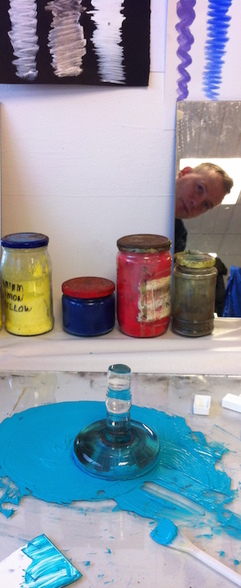Painting

My approach to painting is to always use the finest materials possible. To that end I always prefer to make my own paint, because this gives the vibrant pure colour I desire.
My oil paint consists of pure pigment ground in cold-pressed linseed oil, with no other additives whatsoever. This ritual of grinding my own pigments gives me a close relationship to each one, as well as a deeper understanding of the personality of each pigment, which casually squeezing shop-bought paints from the tube does not give.
Some pigments like vermilion veer towards translucency, while others like cadmium red are opaque. Some colours like cobalt turquoise give off internal light, while others seem to absorb light. Some colours are granular and some are so fine it can be difficult to get them to mix with water. Such is the excitement of making your own paint.
For watercolours I use pigment with gum Arabic, though I have recently begun experimenting with Lascaux aquacryl as a binder, with pleasing results. I also use Lascaux gouache and aquacryl, and favour ongoing experimentation with materials and technique.
I once had a happy and productive affair with egg tempera. This is the Italian Renaissance technique of mixing pigment with egg yolk, which is then painted on a smooth semi-absorbent gesso ground. The intensity of colour with this technique is magical, but unfortunately the cold, damp Shetland climate and egg tempera do not like each other.
I use the best quality papers and canvases that I can afford, but tend to use cheap decorators brushes for most things except the finest detail. Expensive sable brushes are soon ruined after a few days painting on a Shetland beach.
My oil paint consists of pure pigment ground in cold-pressed linseed oil, with no other additives whatsoever. This ritual of grinding my own pigments gives me a close relationship to each one, as well as a deeper understanding of the personality of each pigment, which casually squeezing shop-bought paints from the tube does not give.
Some pigments like vermilion veer towards translucency, while others like cadmium red are opaque. Some colours like cobalt turquoise give off internal light, while others seem to absorb light. Some colours are granular and some are so fine it can be difficult to get them to mix with water. Such is the excitement of making your own paint.
For watercolours I use pigment with gum Arabic, though I have recently begun experimenting with Lascaux aquacryl as a binder, with pleasing results. I also use Lascaux gouache and aquacryl, and favour ongoing experimentation with materials and technique.
I once had a happy and productive affair with egg tempera. This is the Italian Renaissance technique of mixing pigment with egg yolk, which is then painted on a smooth semi-absorbent gesso ground. The intensity of colour with this technique is magical, but unfortunately the cold, damp Shetland climate and egg tempera do not like each other.
I use the best quality papers and canvases that I can afford, but tend to use cheap decorators brushes for most things except the finest detail. Expensive sable brushes are soon ruined after a few days painting on a Shetland beach.



